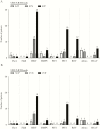Predictive Value of Respiratory Viral Detection in the Upper Respiratory Tract for Infection of the Lower Respiratory Tract With Hematopoietic Stem Cell Transplantation
- PMID: 31541573
- PMCID: PMC7107470
- DOI: 10.1093/infdis/jiz470
Predictive Value of Respiratory Viral Detection in the Upper Respiratory Tract for Infection of the Lower Respiratory Tract With Hematopoietic Stem Cell Transplantation
Abstract
Background: Hematopoietic cell transplant (HCT) recipients are frequently infected with respiratory viruses (RVs) in the upper respiratory tract (URT), but the concordance between URT and lower respiratory tract (LRT) RV detection is not well characterized.
Methods: Hematopoietic cell transplant candidates and recipients with respiratory symptoms and LRT and URT RV testing via multiplex PCR from 2009 to 2016 were included. Logistic regression models were used to analyze risk factors for LRT RV detection.
Results: Two-hundred thirty-five HCT candidates or recipients had URT and LRT RV testing within 3 days. Among 115 subjects (49%) positive for a RV, 37% (42 of 115) had discordant sample pairs. Forty percent (17 of 42) of discordant pairs were positive in the LRT but negative in the URT. Discordance was common for adenovirus (100%), metapneumovirus (44%), rhinovirus (34%), and parainfluenza virus type 3 (28%); respiratory syncytial virus was highly concordant (92%). Likelihood of LRT detection was increased with URT detection (oods ratio [OR] = 73.7; 95% confidence interval [CI], 26.7-204) and in cytomegalovirus-positive recipients (OR = 3.70; 95% CI, 1.30-10.0).
Conclusions: High rates of discordance were observed for certain RVs. Bronchoalveolar lavage sampling may provide useful diagnostic information to guide management in symptomatic HCT candidates and recipients.
Keywords: diagnostics; hematopoietic stem cell transplantation; respiratory viruses.
© The Author(s) 2019. Published by Oxford University Press for the Infectious Diseases Society of America. All rights reserved. For permissions, e-mail: journals.permissions@oup.com.
Figures



References
Publication types
MeSH terms
Grants and funding
LinkOut - more resources
Full Text Sources
Medical

